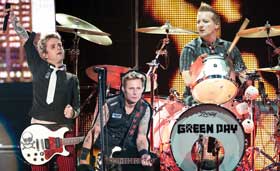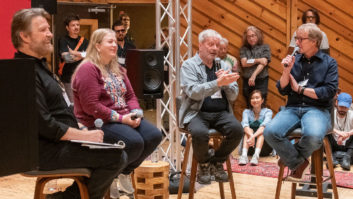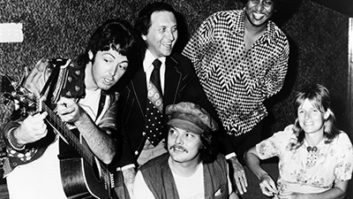
Green Day, from left: Billie Joe Armstrong, Mike Dirnt and Tre Cool
Photos: Steve Jennings
When Green Day finally hit the stage at the Shoreline Amphitheater (Mountain View, Calif.), the sold-out crowd went absolutely wild, eagerly anticipating what the punk-rockers would play from their extensive catalog. Would the set list draw heavily from their latest, 21st Century Breakdown? Radio hits from Dookie? Would they pull out B-sides from back in the days of slugging it through small clubs in their hometown of Berkeley? In fact, they chose a little bit of everything.
And Green Day, over the years, has finely honed their sound—a gritty blend of punk and rock. Sure, it’s a live show, but they want their signature album sound to pulse through the P.A.
Clair Global is providing all gear, including its new Clair i3 compact line array. According to systems tech/crew chief Jason Vrobel, the P.A. comprises 20 i3 boxes per side with 12 Prism subs per side. “In addition, we have four Clair R4s and four S4 subs and some P2 boxes for front-fill, just to fill in some of the spots we’re missing with the P.A.,” Vrobel says. “We’re also using eight Clair IDLs per side [the new two-way delay box] on some shows to fill in the outside of the i3s. I tune the P.A. every day [using a rack full of Clair iOs]. With the shed run in the U.S., it’s fairly consistent with the same sort of EQ we put on the P.A., but here and there we’ll change different frequencies for different rooms. We like the sound of the older amplifiers a little bit better [than Clair’s newer models] because Green Day is a very analog-sounding band; no digital consoles. They’re looking for a distinctive tone out of the P.A. so we’re going a bit more old-school.”
“We definitely want to make it a live experience,” front-of-house engineer Kevin Lemoine adds, “but we don’t want to alienate fans who are coming to the show who are used to hearing the CDs and the songs and the videos. You don’t want to take them too far away from that.” Lemoine, who has been with the band for the past 10 years, mixes with that in mind, but is also contending with a few extra musicians to help bolster the sound. Jason Freeze plays piano, sax, accordion and Hammond B3, as well as contributing background vocals; Jason White offers his acoustic and electric guitar playing, as well as background vocals; and Jeff Matika, guitarist. The addition of these extra touring musicians, says Lemoine, “fills out the sound of the records that have come out since 2004. Their albums have gotten more advanced and they wanted to [mirror] that live. It helps [my mix] a lot because there’s more things going on and it makes it sound bigger. I’ve got a lot more channels, but that’s just fine.”
Those extra channels are housed in his Midas XL4 board. (He started using an API Paragon II at the onset of the tour but switched to the Midas about halfway through the North American dates.) “The Paragon is an older console and things just stopped working on it,” Lemoine says of the switch. “We’d have to change out input strips and preamp modules a lot; maybe once every five days. I found the sound of it to be true and uncolored while the Midas brought a bit more grit to the mix. I like the Midas a lot; it’s a 12-year-old console we’re using, but it’s really held up well.”
Monitor engineer Beau Alexander—who is also quite familiar with the band’s tone, having worked with them as a monitor tech in 2004 and then as monitor engineer since 2005—mans a Studer Vista 5 console, using the board’s 96 inputs and 56 outs. “A lot of the reason why I chose this console initially is because of the outputs I have. I wasn’t sure [at rehearsals for this tour] if we were going to use wedges or in-ears. When we first started, I built mixes for wedges and in-ears at the same time.” Since then, the band has opted to all go on in-ears (Ultimate Ears UE-11s), a switch that was brought forth by the bandmembers themselves; previous tours saw Billie Joe Armstrong (vocals/guitar), Tre Cool (drums) and Mike Dirnt (bass) on wedges and the support musicians on in-ears. “I went from mixing wedges, where I basically had a fixed mono spot, to a big, broad stereo mix, and they can run all over [the stage] and still hear what’s going on,” Alexander says. “With a stereo spectrum, I’m able to do a lot more with the mix and create a bigger atmosphere, which is lot more fun for me—getting creative with the mix.”

Jason Vrobel (left) and Kevin Lemoine at the Midas XL4
Alexander is giving each bandmember a pretty straightforward mix, but creating a stereo image where each performer can hear everything. “They like to be in touch with what everybody’s doing,” Alexander says. “Now that we’re getting into more background vocals, it’s a lot of spreading out vocals so they can harmonize together. With each individual input we have, they work really hard on creating a certain sound that they like to use for their instruments. My job is to present them with the way things are actually sounding instead of doctoring it up. With Tre, he likes to hear what his drums are actually doing, not like Kevin out front who is EQ’ing to make it sound more like the record.”
Lemoine also keeps his mix pretty clean, invoking a few delays and reverbs, as well as an Eventide Harmonizer on background vocals. But where his mix gets a bit heavy is on the mic side. Cool’s kit is miked with a Beta 91, a Neumann 170 and a Lawson FET47 reproduction on kick; a Telefunken M80 and an AKG 414 on snare top, and a Neumann 184 for bottom; a Neumann 184 on hi-hat; and Beta 98s on rack toms. Floor toms are miked with Josephson e22S because “Tre is a very dynamic player,” Lemoine explains. “He’ll hit with the strength of an elephant and the next second it’ll sound like a fly just landed on the tom tom. We had to find a mic for the floor tom that would allow for that dynamic range. Cymbals are individually miked with 184s underneath. Overheads are Telefunken stereo single-source M215s—it’s their version of an AKG C24. They’re placed four feet above Tre’s head and bring in some ambience. ”

Monitor engineer Beau Alexander at the Studer Vista 5
Other mics include a Neumann TLM 103 on bass cab (taken DI out of a Vintech 1073), an SM7, a Sennheiser 421 and two Neumann 103s for each of Armstrong’s two Marshall heads (going into two 4x12s). Freeze’s piano is taken DI, while his Leslie is miked with an old AKG D12 (bottom) and Shure Beta 91 (top); his sax takes a clip-on Audio-Technica mic. Guitarist Jeff Matika plays his axe through a Fender BassMan, which has an SM7. Extra guitarist White has a similar setup to Armstrong’s, with the exception that each cab as a TLM 103 on it. “He also has a [Placid Audio] Copperphone—an effects microphone—that sounds like a real telephone,” Lemoine adds. “I only use it on a couple of songs.”
Everybody sings into Telefunken M80s, which were given a bit of a facelift. “Telefunken put their M80 capsule onto a Shure handheld wireless for Billie’s vocal because he uses a wireless,” Lemoine says. “We’ve used Shure 58 capsules on top of the Shure radio mics forever, and we sent [Telefunken] a handheld unit and they retrofitted it with the M80 capsule on top. They sound amazing, so we got them to do 40 of them for us because it’s an aggressive show and Billie goes through one every other show. It sounds amazing.”
“It’s a rock band and they have a lot of inputs, but I tend to lean more toward high-end microphones and preamps just due to the nature of the show,” Lemoine adds. “It’s a very hi-fi, traditionally inspired show. The audience has to be able to hear every little thing. Mike doesn’t play your traditional bass line; he’s more melodic. Most of the time he carries the song, along with the vocal. The two guitar players [Armstrong and White] have to be distinguished from each other so the tones have to be pretty specific. And everybody’s vocal has to be there. It’s pretty challenging to do that over 20,000 screaming kids, but I love it, it’s a lot of fun!”
But what has Lemoine all excited is the prospect of his own FOH rig for the next tour. Right now, they’re trying out different pieces of gear, including a Neve 5088 16-channel console, a slew of Chandler Limited items—“the best of the best,” Lemoine enthuses. “I don’t like the way digital consoles sound. And I’m taking cues from the guys back in the ’40s and ’50s who were doing early recordings where things that they needed to do their job simply didn’t exist. That’s where I’m sitting right now. We’re going to make our own stuff up.”
Sarah Benzuly is
Mix
’s managing editor.



